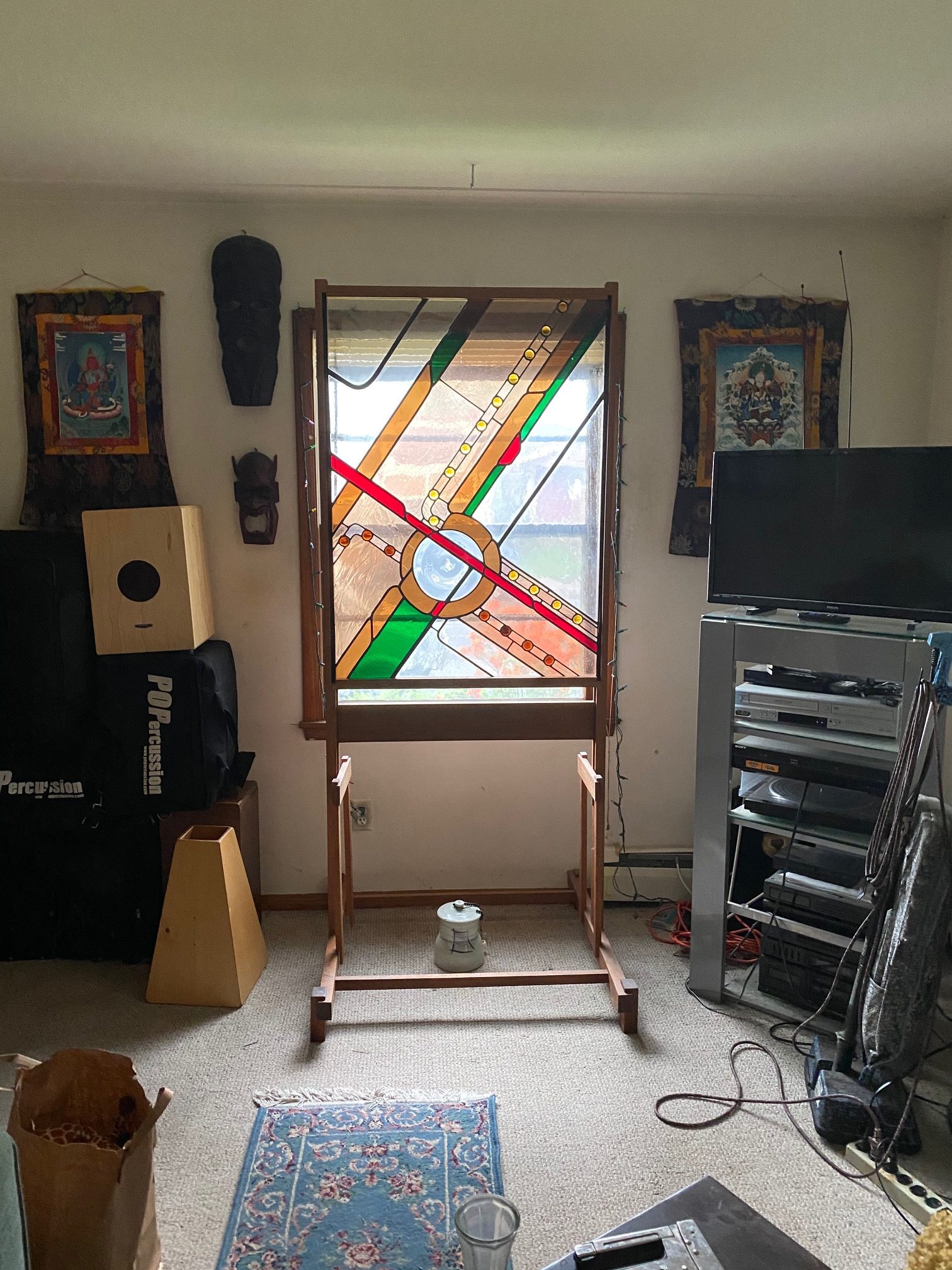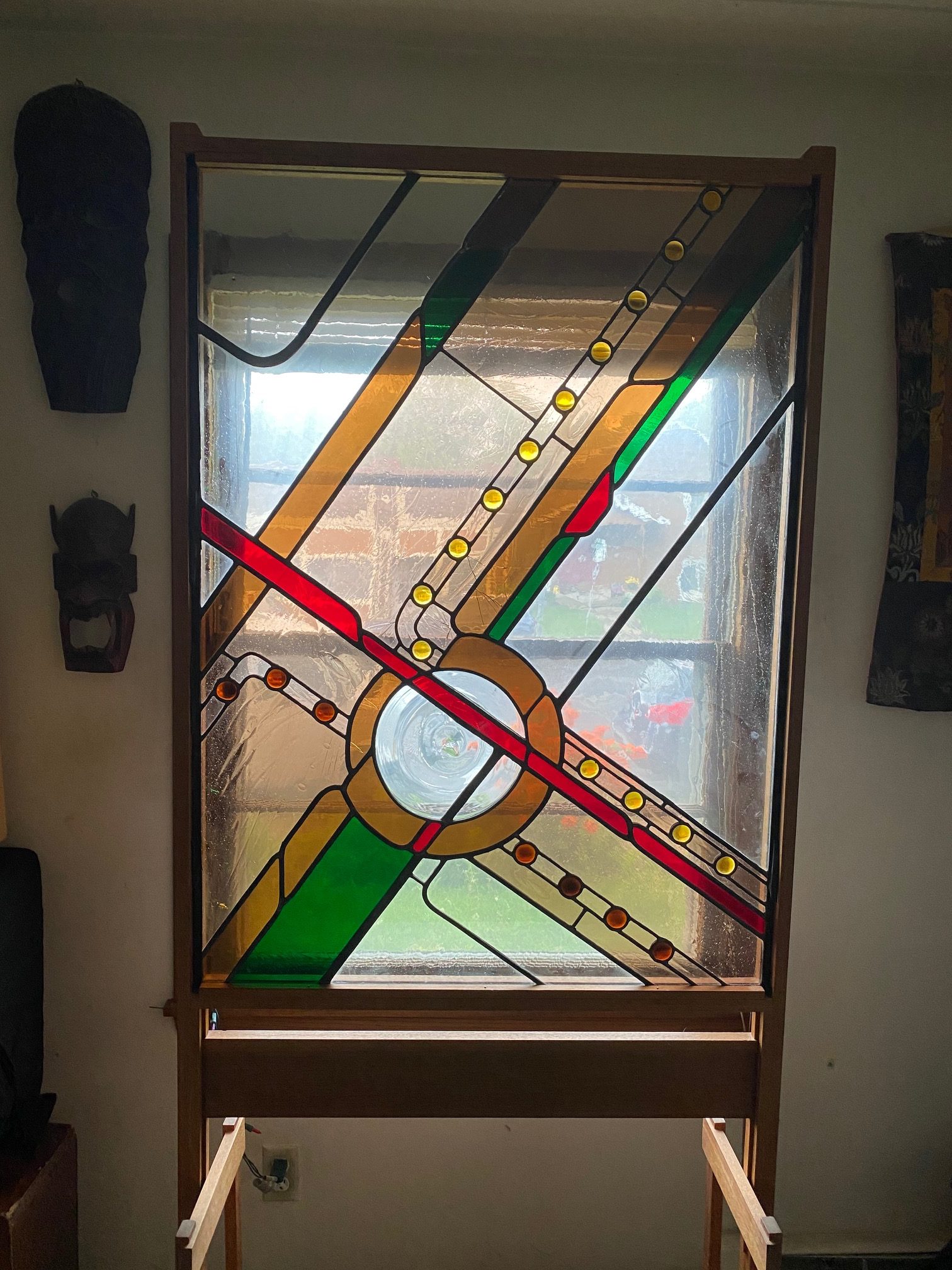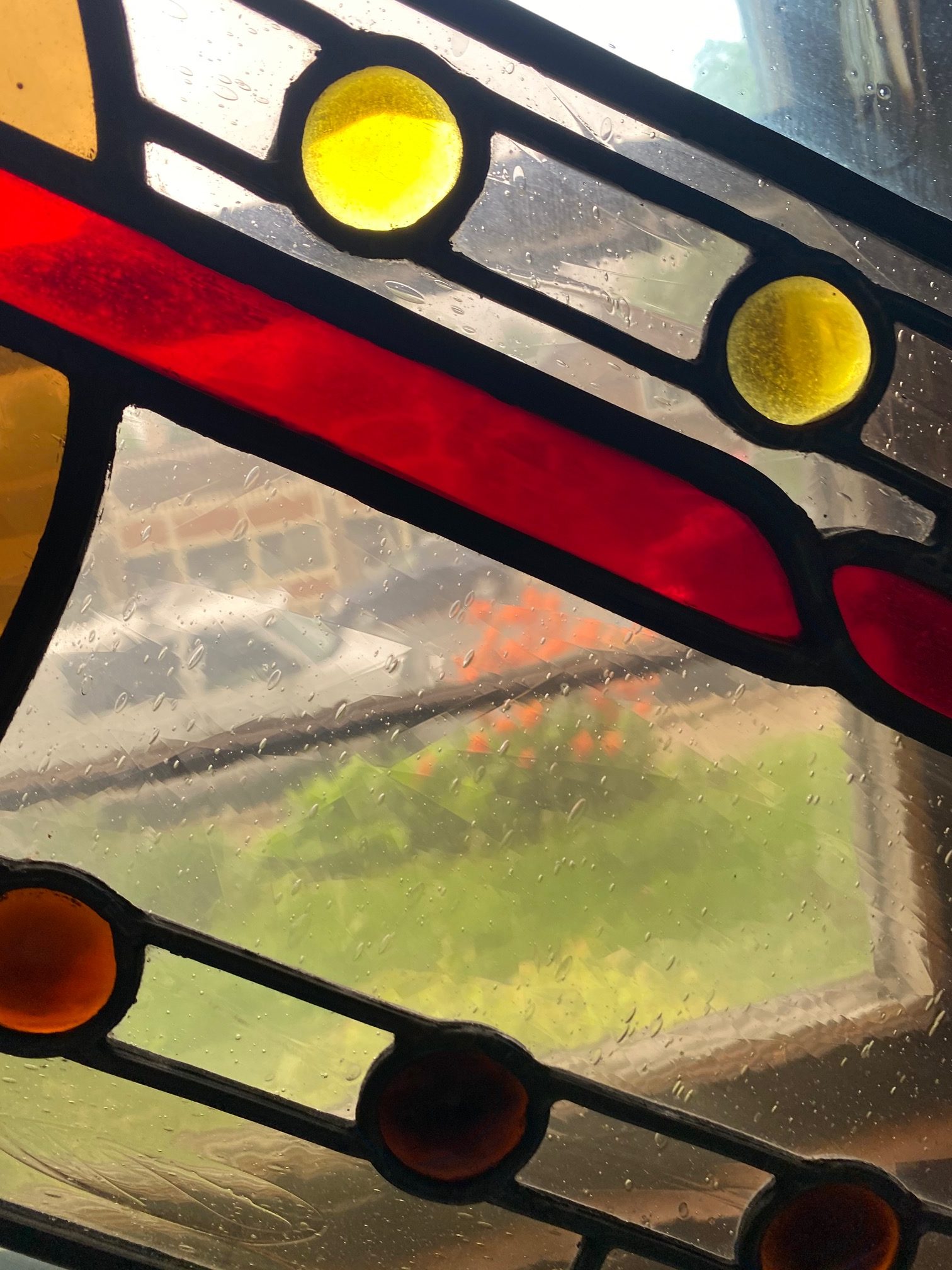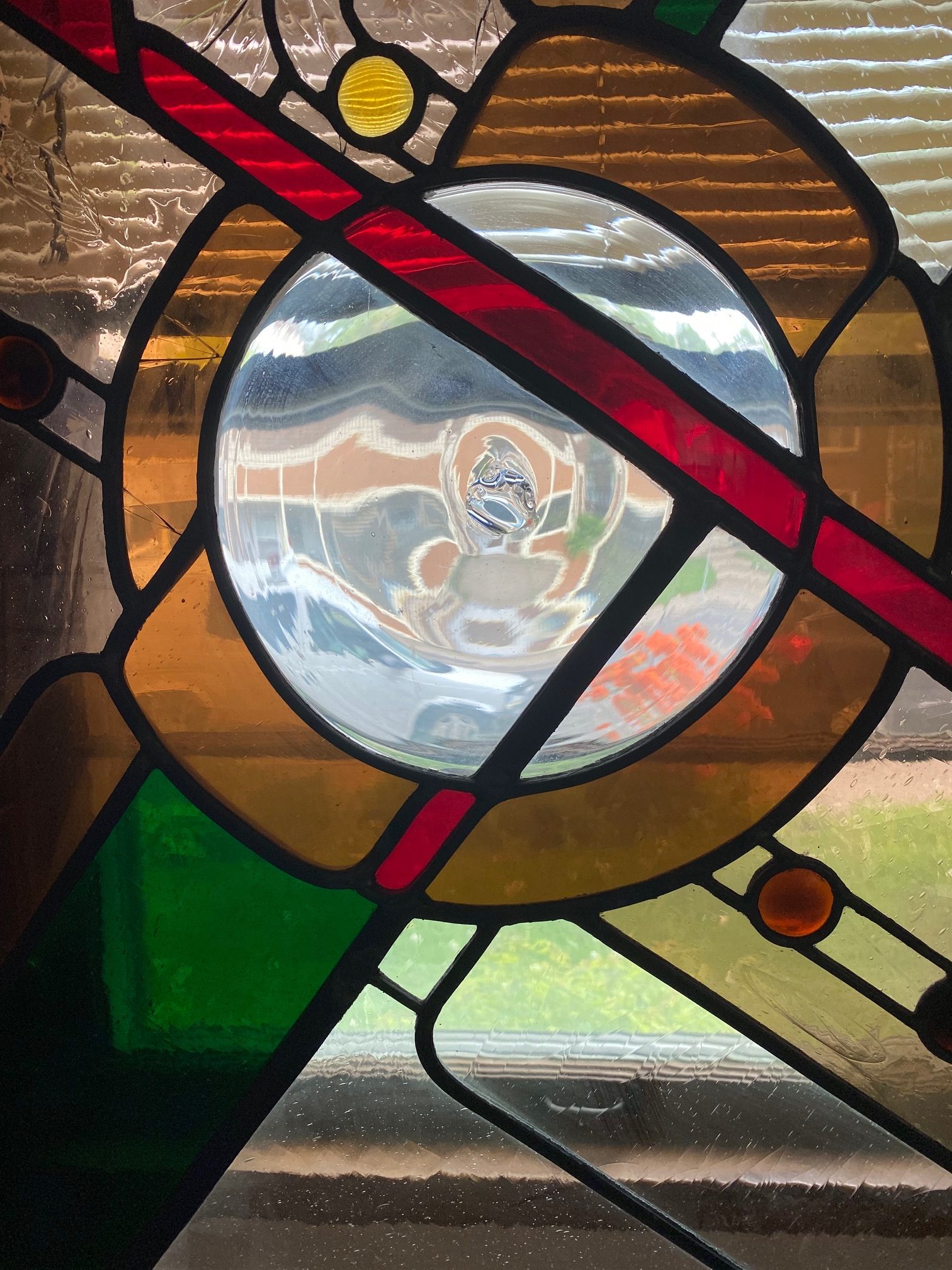Blog
While hunting for glass projects primarily to repair, I ran across this very unusual piece. The collector practically donated it to me. As soon as I walked in my front door I immediately knew this window was the new Diego Memorial object. The old memorial with Diegos ashes, toys, pics, objects of Diego were full of dust and very painful memories withering away. The new window brings new life into Diegos life. How wonderful.




more...
Near the heart of the Virgo Galaxy Cluster the string of galaxies known as Markarian’s Chain stretches across this deep telescopic field of view. Anchored in the frame at bottom center by prominent lenticular galaxies, M84 (bottom) and M86, you can follow the chain up and to the right. Near center you’ll spot the pair of interacting galaxies NGC 4438 and NGC 4435, known to some as Markarian’s Eyes. Its center an estimated 50 million light-years distant, the Virgo Cluster itself is the nearest galaxy cluster. With up to about 2,000 member galaxies, it has a noticeable gravitational influence on our own Local Group of Galaxies. Within the Virgo Cluster at least seven galaxies in Markarian’s Chain appear to move coherently, although others may appear to be part of the chain by chance.

Ian Robertson Underwood (born May 22, 1939) is a woodwind and keyboards player, known for his work with Frank Zappa and the Mothers of Invention.
Underwood graduated from The Choate School in 1957 and Yale University with a bachelor’s degree in composition in 1961 and a master’s degree in composition at UC Berkeley in 1966. He began his career by playing San Francisco Bay Area coffeehouses and bars with his improvisational group, the Jazz Mice, in the mid 1960s before he became a member of Frank Zappa and the Mothers of Invention in 1967 for their third studio album, We’re Only in It for the Money. He speaks on Uncle Meat; on the track “Ian Underwood Whips It Out” he relates how he first met Zappa and demonstrated his capabilities on the saxophone at Zappa’s invitation. Underwood later worked with Frank Zappa on his solo recordings, including 1969’s Hot Rats. He married Ruth Komanoff (Underwood), marimbist/percussionist from the Mothers of Invention in May 1969. Underwood left the Mothers of Invention in September 1973. He and Ruth divorced in 1986.
After his lengthy career with Frank Zappa, he pursued a career as a session keyboardist. Underwood has since been proficient on the Minimoog synthesizer, mostly in film. He has been credited in recordings for Quincy Jones, Barbra Streisand, Ronee Blakley, Hugh Cornwell, Freddie Hubbard, Jean-Luc Ponty, Herb Alpert, Hugh Masekela, Peggy Lee, Dolly Parton, Chicago, Janet Jackson, Dave Grusin, Jefferson Airplane, Frankie Valli, the Carpenters, James Ingram, and Barry Manilow. Underwood was also one of the musicians who played the main title theme for the 1980s hit series Knight Rider. Underwood was the uncredited producer of the debut album by Alice Cooper, Pretties For You, in 1969.
more...Richard Alan Berk (May 22, 1939 – February 8, 2014) was an American jazz drummer and bandleader.
A native of San Francisco, California, he studied at the Berklee College of Music and played in the Boston area early in the 1960s. In 1962 he moved to New York City and played with Ted Curson and Bill Barron in a quintet from 1962 to 1964. Following this he played with Charles Mingus, Mose Allison, Freddie Hubbard, and Walter Bishop, Jr., among others. He moved to Los Angeles late in the 1960s, where he played with Milt Jackson, George Duke, Cal Tjader, Jean-Luc Ponty, and Blue Mitchell. He founded the Jazz Adoption Agency in the early 1980s, playing into the 2000s; the group included Andy Martin, Mike Fahn, Nick Brignola, Jon Nagorney, Keith Saunders, Tad Weed, and John Patitucci. He died in 2014 at the age of 74.
more...Le Sony’r Ra (born Herman Poole Blount, May 22, 1914 – May 30, 1993), better known as Sun Ra, was an American jazz composer, bandleader, piano and synthesizer player, and poet known for his experimental music, “cosmic” philosophy, prolific output, and theatrical performances. For much of his career, Ra led “The Arkestra,” an ensemble with an ever-changing name and flexible line-up.
Born and raised in Alabama, Blount became involved in the Chicago jazz scene during the late 1940s. He soon abandoned his birth name, taking the name Le Sony’r Ra, shortened to Sun Ra (after Ra, the Egyptian God of the Sun). Claiming to be an alien from Saturn on a mission to preach peace, he developed a mythical persona and an idiosyncratic credo that made him a pioneer of Afrofuturism.Throughout his life he denied ties to his prior identity saying, “Any name that I use other than Ra is a pseudonym.”
His widely eclectic and avant-garde music echoed the entire history of jazz, from ragtime and early New Orleans hot jazz, to swing music, bebop, free jazz and fusion. His compositions ranged from keyboard solos to works for big bands of over 30 musicians, along with electronic excursions, songs, chants, percussion pieces, and anthems. From the mid-1950s until his death, Ra led the musical collective The Arkestra (which featured artists such as Marshall Allen, John Gilmore and June Tyson throughout its various iterations). Its performances often included dancers and musicians dressed in elaborate, futuristic costumes inspired by ancient Egyptian attire and the Space Age. (Following Ra’s illness-forced retirement in 1992, the band remained active as The Sun Ra Arkestra, and, as of 2018, continues performing under the leadership of veteran Ra sideman Marshall Allen.) Though his mainstream success was limited, Sun Ra was a prolific recording artist and frequent live performer, and remained influential throughout his life for his music and persona. He is now widely considered an innovator; among his distinctions are his pioneering work in free improvisation and modal jazz and his early use of electronic keyboards and synthesizers. Over the course of his career, he recorded dozens of singles and over one hundred full-length albums, comprising well over 1,000 songs, making him one of the most prolific recording artists of the 20th century.
He was born Herman Blount on May 22, 1914, in Birmingham, Alabama, as discovered by his biographer, John F. Szwed, and published in his 1998 book. He was named after the popular vaudeville stage magician Black Herman, who had deeply impressed his mother. He was nicknamed “Sonny” from his childhood, had an older sister and half-brother, and was doted upon by his mother and grandmother.
For decades, very little was known about Sun Ra’s early life, and he contributed to its mystique. As a self-invented person, he routinely gave evasive, contradictory or seemingly nonsensical answers to personal questions, and denied his birth name. He speculated, only half in jest, that he was distantly related to Elijah Poole, later known as Elijah Muhammad, leader of the Nation of Islam. His birthday for years remained unknown, as his claims ranged from 1910 to 1918. Only a few years before his death, the date of Sun Ra’s birth was still a mystery. Jim Macnie’s notes for Blue Delight (1989) said that Sun Ra was believed to be about 75 years old. But Szwed was able to uncover a wealth of information about his early life and confirmed a birth date of May 22, 1914. As a child, Blount was a skilled pianist. By the age of 11 or 12, he was composing and sight reading music. Birmingham was an important stop for touring musicians and he saw prominent musicians such as Fletcher Henderson, Duke Ellington, and Fats Waller, and others now forgotten. Sun Ra once said, “The world let down a lot of good musicians”.
In his teenage years, Blount demonstrated prodigious musical talent: many times, according to acquaintances, he went to big band performances and then produced full transcriptions of the bands’ songs from memory. By his mid-teens, Blount was performing semi-professionally as a solo pianist, or as a member of various ad hoc jazz and R&B groups. He attended Birmingham’s segregated Industrial High School (now known as Parker High School), where he studied under music teacher John T. “Fess” Whatley, a demanding disciplinarian who was widely respected and whose classes produced many professional musicians. Though deeply religious, his family was not formally associated with any Christian church or sect. Blount had few or no close friends in high school but was remembered as kind-natured and quiet, an honor roll student, and a voracious reader. He took advantage of the Black Masonic Lodge as one of the few places in Birmingham where African Americans had unlimited access to books. Its collection on Freemasonry and other esoteric concepts made a strong impression on him. By his teens, Blount suffered from cryptorchidism. It left him with a nearly constant discomfort that sometimes flared into severe pain. Szwed suggests that Blount felt shame about it and the condition contributed to his isolation.
more...This packed ESA/Hubble Picture of the Week showcases the galaxy cluster ACO S 295, as well as a jostling crowd of background galaxies and foreground stars. Galaxies of all shapes and sizes populate this image, ranging from stately spirals to fuzzy ellipticals. As well as a range of sizes, this galactic menagerie boasts a range of orientations, with spiral galaxies such as the one at the centre of this image appearing almost face on, and some edge-on spiral galaxies visible only as thin slivers of light. The cluster dominates the centre of this image, both visually and physically. The huge mass of the galaxy cluster has gravitationally lensed the background galaxies, distorting and smearing their shapes. As well as providing astronomers with a natural magnifying glass with which to study distant galaxies, gravitational lensing has subtly framed the centre of this image, producing a visually striking scene.

Larance Norman Marable (May 21, 1929 – July 4, 2012) was a jazz drummer from Los Angeles, California.
Marable was born in Los Angeles on May 21, 1929. His family was musical, but he was largely self-taught.
In the 1950s, Marable played with musicians who were visiting Los Angeles; these included Dexter Gordon, Charlie Parker, and Zoot Sims. Marable recorded as a leader in 1956. He also recorded with George Shearing, Chet Baker, Milt Jackson, and other well-known musicians.
Drug problems led to Marable stopping playing in the 1960s. His career resumed in the mid-1970s, after he had ended his drug addiction. He toured with Supersax and Bobby Hutcherson in the 1970s, and was a member of Charlie Haden‘s Quartet West in the 1980s and 1990s.
Marable had a stroke in the 2000s and lived in a health care facility. He died in Manhattan on July 4, 2012.
https://www.youtube.com/watch?v=LW63MKyhSa4
more...Thomas Wright “Fats” Waller (May 21, 1904 – December 15, 1943) was an American jazz pianist, organist, composer, violinist, singer, and comedic entertainer. His innovations in the Harlem stride style laid the groundwork for modern jazz piano. His best-known compositions, “Ain’t Misbehavin’” and “Honeysuckle Rose“, were inducted into the Grammy Hall of Fame in 1984 and 1999. Waller copyrighted over 400 songs, many of them co-written with his closest collaborator, Andy Razaf. Razaf described his partner as “the soul of melody… a man who made the piano sing… both big in body and in mind… known for his generosity… a bubbling bundle of joy”. It is possible financial circumstances caused him to compose many more popular songs and sell them to other performers.
Waller started playing the piano at the age of six, and became a professional organist at age 15. By the age of 18, he was a recording artist. Waller’s first recordings, “Muscle Shoals Blues” and “Birmingham Blues”, were made in October 1922 for Okeh Records. That year, he also made his first player piano roll, “Got to Cool My Doggies Now”. Waller’s first published composition, “Squeeze Me“, was published in 1924. He became one of the most popular performers of his era, touring internationally and achieving critical and commercial success in the United States and Europe. He died from pneumonia, aged 39.
Waller was the seventh child of 11 (five of whom survived childhood) born to Adeline Locket Waller, a musician, and Reverend Edward Martin Waller, a trucker and pastor in New York City. He started playing the piano when he was six and graduated to playing the organ at his father’s church four years later. His mother instructed him in his youth, and he attended other music lessons, paying for them by working in a grocery store. Waller attended DeWitt Clinton High School for one semester, but left school at 15 to work as an organist at the Lincoln Theater in Harlem, where he earned $32 a week. Within 12 months he had composed his first rag. He was the prize pupil and later the friend and colleague of the stride pianist James P. Johnson. His mother died on November 10, 1920 from a stroke due to diabetes. Waller contracted pneumonia and died on December 15, 1943, while traveling aboard the famous cross-country Los Angeles–Chicago train the Super Chief near Kansas City, Missouri. His final recording session was with an interracial group in Detroit, Michigan, that included white trumpeter Don Hirleman. Waller was returning to New York City from Los Angeles, after the smash success of Stormy Weather, and after a successful engagement at the Zanzibar Room in Santa Monica, California, during which he had fallen ill.[29]:6 More than 4,200 people were estimated to have attended his funeral at Abyssinian Baptist Church in Harlem.
more...Tientos is a flamenco Andalusian palo which has a rhythm consisting of 4 beats. It is in the same family as the Tangos, but slower and with different topics, lyrics and mood. Every Tientos becomes a Tangos at the end of the song/dance. Traditionally, cantaor El Marrurro (1848 -1906) has been considered one of the creators of this style. Enrique el Mellizo gave it the modern form by which we know it today. Other famous cantaores who interpreted this style were Antonio Chacón and Pastora Pavón.
Like many Cante Jondo, traditional Tientos lyrics (letras) tend to be pathetic, sentimental, and speak about the lack of love, disillusionment and revenge. Dancers strive to capture this mood in their solos. It can be danced by a man or a woman.
The structure is similar to most Flamenco dances and can be broken down as follows:
- Guitar intro
- Song intro
- Footwork intro and llamada
- First letra, punctuated by a footwork during the respiro ‑ a break in the song after the second line of letra
- Guitar falsetta
- Escobilla (footwork section)
- Second letra
- Second escobilla
- Subida
- Macho or Tangos to close
In 1716, English astronomer Edmond Halley noted, “This is but a little Patch, but it shews itself to the naked Eye, when the Sky is serene and the Moon absent.” Of course, M13 is now less modestly recognized as the Great Globular Cluster in Hercules, one of the brightest globular star clusters in the northern sky. Sharp telescopic views like this one reveal the spectacular cluster’s hundreds of thousands of stars. At a distance of 25,000 light-years, the cluster stars crowd into a region 150 light-years in diameter. Approaching the cluster core upwards of 100 stars could be contained in a cube just 3 light-years on a side. For comparison, the closest star to the Sun is over 4 light-years away. The remarkable range of brightness recorded in this image follows stars into the dense cluster core. Distant background galaxies in the medium-wide field of view include NGC 6207 at the lower right.

John Robert “Joe” Cocker OBE (20 May 1944 – 22 December 2014) was an English singer known for his gritty voice and dynamic stage performances that featured spastic body movements. Most of his best known singles were covers of songs by other artists, though he composed a number of his own songs for most of his albums as well, often in conjunction with songwriting partner Chris Stainton.
His first album featured a recording of the Beatles‘ “With a Little Help from My Friends“, which brought him to near instant stardom. The song reached number one in the UK in 1968, became a staple of his many live shows, and became known to later generations as the theme song for the TV series The Wonder Years. He continued his successes with his his second album, which included a second Beatles cover, “She Came In Through the Bathroom Window“. Capitalizing on his success, a hastily thrown together 1970 U.S. tour led to the live double-album Mad Dogs & Englishmen, which featured an all-star band organized by Leon Russell. His 1974 cover of “You Are So Beautiful” reached number five in the US, and became his signature song. Cocker’s best selling song was the US number one “Up Where We Belong“, a duet with Jennifer Warnes that earned a 1983 Grammy Award. He released a total of 22 studio albums over a 43-year recording career.
In 1993, Cocker was nominated for the Brit Award for Best British Male, in 2007 was awarded a bronze Sheffield Legends plaque in his hometown and in 2008 he received an OBE at Buckingham Palace for services to music. Cocker was ranked number 97 on Rolling Stone‘s 100 greatest singers list.
more...Victor Lewis (born May 20, 1950) is an American jazz drummer, composer, and educator.
Victor Lewis was born on May 20, 1950 in Omaha, Nebraska. His father, Richard Lewis, who played saxophone and mother, Camille, a pianist-vocalist were both classically trained musicians who performed with many of the “territory bands” that toured the midwest in the forties. Consequently, Victor grew up with jazz as well as popular and European classical music at home. He would also go with his father to hear touring big bands as they passed through Omaha, such as Duke Ellington, Count Basie and Woody Herman.
Victor started studying music when he was ten and a half years old. Too small for the acoustic bass, he began on cello, but switched to the drums a year and a half later inspired by the drum line marching in holiday parades. As part of his formal studies, he also studied classical piano.
https://www.youtube.com/watch?v=JMLqeoM-j4k
more...Frederick Earl “Shorty” Long (May 20, 1940 – June 29, 1969) was an American soul singer, songwriter, musician, and record producer for Motown‘s Soul Records imprint. He was inducted into the Alabama Jazz Hall of Fame in 1980.
Born in Birmingham, Alabama, Long came to Motown in 1963 from the Tri-Phi/Harvey label, owned by Berry Gordy‘s sister, Gwen, and her husband, Harvey Fuqua. His first release, “Devil with the Blue Dress On” (1964), written with William “Mickey” Stevenson, was the first recording issued on Motown’s Soul label, a subsidiary designed for more blues-based artists such as Long.While this song never charted nationally, the song was covered and made a hit in 1966 by Mitch Ryder and the Detroit Wheels. Long’s 1966 single “Function at the Junction” was his first popular hit, reaching No. 42 on the national R&B charts. Other single releases included “It’s a Crying Shame” (1964), “Chantilly Lace” (1967), and “Night Fo’ Last” (1968).
Long’s biggest hit was “Here Comes the Judge” which in July 1968 reached No. 4 on the R&B charts and No. 8 eight on the Billboard Hot 100. The song was inspired by a comic act on Rowan and Martin’s Laugh-In about a judge by Pigmeat Markham, whose own “Here Comes the Judge” – a similar song with different lyrics – charted three weeks after Long’s, also in July 1968, and reached No. 19 on Billboard. Long’s 1969 singles included “I Had a Dream” and “A Whiter Shade of Pale“. He released one album during his lifetime, Here Comes the Judge (1968).
Long played many instruments, including piano, organ, drums, harmonica, and trumpet. He acted as an MC for many of the Motortown Revue shows and tours, and co-wrote several of his tunes (“Devil with the Blue Dress On”, “Function at the Junction”, and “Here Comes the Judge“). Long was the only Motown artist besides Smokey Robinson who was allowed to produce his own recordings in the 1960s. Marvin Gaye, in David Ritz‘s biography Divided Soul: The Life & Times of Marvin Gaye, described Shorty Long as “this beautiful cat who had two hits, and then got ignored by Motown.” Gaye claimed he “fought for guys like Shorty” while at Motown, since no one ever pushed for these artists. When Holland-Dozier-Holland came to Gaye with a tune, he stated, “Why are you going to produce me? Why don’t you produce Shorty Long?”
On June 29, 1969, Long and a friend drowned when their boat crashed on the Detroit River in Michigan. Stevie Wonder played the harmonica at his burial, and placed it on his casket afterwards. Writer Roger Green’s epitaph stated: “So there endeth the career of a man who sang what he wanted to sing – everything from the blues to romantic ballads, from wild and crazy numbers to a utopian vision of Heaven on Earth. Short in stature but big in talent, he entertained and amazed us, and finally he inspired us.”
Motown released Long’s final album, The Prime of Shorty Long, shortly after his death.
more...Marinella (Greek: Μαρινέλλα) (born 20 May 1938, Thessaloniki) is one of the most popular Greek singers whose career has spanned several decades. She has sung professionally since 1957. Since the beginning of her career, she has released 66 solo albums and has been featured on albums by other musicians.
She was born Kyriaki Papadopoulou (Κυριακή Παπαδοπούλου), in the city of Thessaloniki in northern Greece. Her parents were Greek refugees from Constantinople. She is the fourth and last child of a large family, which despite its poverty, was rich in love and in artistic vein. The whole family gathered around the turntable and sang, while her father tried to teach children the steps of the waltz and the tango. From the age of four years singing on the radio broadcast in “Pediki Ora (Children’s Hour)” and later did ads for shops such as “Melka” in Thessaloniki, earning her first pocket money. She participated in many performances of children’s theatre.
At age 15, she gave up her budding career to finish school, but by seventeen, her passion for the theatre is stirring and she joins the artistic group of Mary Laurent, a “mpoulouki” (so called then the singer troupes that traveled Greece end-to-end for performances) and plays small roles. One day, the lead singer fell sick and sought Marinella as a replacement, who was willing to take the singer’s place. At that moment, the Greek music world found one of its best representatives. Marinella became the lead singer of the troupe. She later joined the Military Theatre because the remuneration was better. At the same time she started her career as a singer at the “Panorama” centre of Thessaloniki, where Tolis Harmas[who?] coined the name “Marinella” for her, inspired by his song.
more...Edward Louis Smith (May 20, 1931 – August 20, 2016) was an American jazz trumpeter from Memphis, Tennessee.
After graduating from Tennessee State University he attended graduate school at the University of Michigan. While studying at the University of Michigan, he played with visiting musicians such as Dizzy Gillespie, Miles Davis, Thad Jones and Billy Mitchell, before going on to play with Sonny Stitt, Count Basie and Al McKibbon, Cannonball Adderley, Percy Heath, Philly Joe Jones, Lou Donaldson, Donald Byrd, Kenny Dorham and Zoot Sims. Smith decided to forgo being a full-time musician to take a job a director of Atlanta’s Booker T. Washington High School. There he recorded two albums for Blue Note.
The first, Here Comes Louis Smith, originally recorded for the Boston-based Transition Records, featured Cannonball Adderley (then under contract to Mercury) playing under the pseudonym “Buckshot La Funke”, Tommy Flanagan, Duke Jordan, Art Taylor and Doug Watkins. He also replaced Donald Byrd for Horace Silver’s Live at the Newport 1958 set. His playing on the set was one of his best efforts and was described by one critic as “monstrous”. He was a prolific composer and successful band director leaving Booker T. Washington to become director of the Jazz Ensemble at the University of Michigan and a teacher in Ann Arbor’s public school system. He later recorded for the SteepleChase label.
Smith suffered a stroke in 2006, and was seen occasionally enjoying live jazz in the Detroit/Ann Arbor area, but did not return to performing.
His cousin Booker Little was also a trumpeter.
Smith died on August 20, 2016, at age 85.
more...More Posts
- Daily Roots with Freddy McKay
- The Cosmos with NGC 628
- Hermeto Pascoal Day
- Kris Kristofferson Day
- Ray Mantilla Day
- World Music with Asmâa Hamzaoui & Bnat Timbouktou
- Daily Roots with Devon Russell
- Happy Summer Solstice 2019
- The Cosmos with NGC 1169
- Augustus Pablo Day
- Lalo Schifrin Day
- Alexander Lagoya Day
- Skip James Day
- World Music with Cameron y Tomatito
- Daily Roots with Anthony Creary
- The Cosmos with M106/NGC 4217
- Lazy Lester Day
- Eric Dolphy Day
- World Music with Hope Masike
- Daily Roots with the Abysinnians